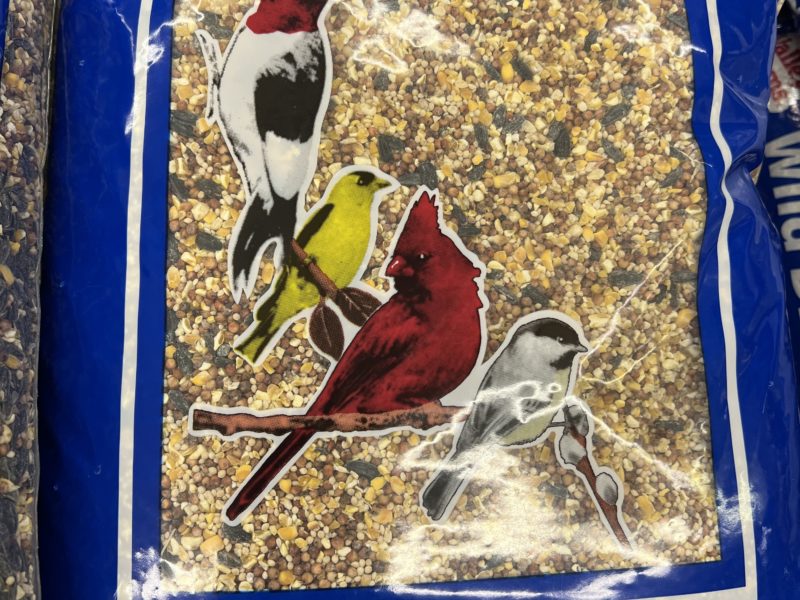

Yes, it’s the end of the year and, yes, it’s the holidays, but there may be something and someone you have forgotten to take care of outside.
Your birds.
I’ve always had mixed feelings about winter bird feeders, not to mention bird feeders in general, and due to a mysterious die-off of several bird species in the past year, some suspected it was the result of contaminated bird food. Thankfully, this has been disproven. But why feed our winter birds if they’ve survived for centuries without our help?
Well, to some degree, they have. But in recent years, we’ve seen a general to massive decline in certain bird populations. Not all reasons for this are clear, but habitat removal is one culprit. Feral and house cats wandering outdoors have also contributed, and certainly climate change is playing a role.
A bit of good news, though, is that because we’ve done so much ornamental planting of trees, shrubs, annuals and perennials in our urban and suburban neighborhoods, we’ve provided new and expanded sanctuaries for many species of birds — as well as many new seed sources.
Nonetheless, there are times during the winter when Mother Nature can make it difficult to nearly impossible for many bird species to find food. This is where we can step in and offer help — but educate yourself first. While you may be well-intentioned, if you don’t provide the proper feeding spots and food, you could cause more harm than good.
So, let’s take a short, but logical, look at winter bird feeding that may give birds the help they need, while simultaneously offering you and your family incredible opportunities to watch and learn from these feathered friends.
There are three important factors to consider — the feeder, the seed used and the feeder location — but before we get to those, let’s talk about your cat.
If you have a house cat that you allow to roam outdoors, you may be part of the problem. Cats, by their nature, like the stalk, then they wait and eventually pounce. It’s not their fault; it’s instinct. But they can do incredible damage to bird populations and that’s an accepted fact. So, what can you do? Well, if you must allow your cat outdoors, put a bell on its collar. It’s a simple step, but it may be very effective.
Next comes the feeder. If you go to a garden center or hardware store, you’re likely to find a wide selection. There may be a few, or there can be dozens, and the prices range from a few dollars to hundreds. Keep in mind that different foods go into different feeders — and different birds may not all go to the same feeder.
The smallest feeders are usually designed to hold nyjer, which we often call “thistle seed.” They are usually shaped like small cylinders with tiny slits cut into the sides, where the birds pull out the seed. This type of feeder is good for many of the finches, sparrows, redpolls, juncos and, from time to time, woodpeckers, thrushes, chickadees, and other birds.
Larger seed feeders are available in any number of shapes and sizes, holding from just a few ounces to pounds of seed. I’ve found the plastic cylinder types to be easy to fill and use, but they are hard to protect from squirrels. The cheaper types only have plastic ports on the sides, where the birds perch and pull out the seed. However, squirrels will chew at the plastic port to make the holes larger. The higher-quality feeders of this type will have metal ports that cannot be damaged by squirrels, and these will last for years.
Seed feeders also come in the shape of small wooden houses with glass on two sides. The feeder is filled from the top and small spaces at the bottom of the glass windows allow the seed to accumulate just at the bottom. This type is virtually impossible to squirrel proof and larger birds, like blue jays, tend to scatter as much seed onto the ground as they eat from the feeder.
You’ll also find hybrid seed feeders in a variety of forms. Some claim to be squirrel proof, but these are also the most expensive. And if you think that a feeder on a pole with a squirrel baffle is your solution, guess again. Squirrels are cunning and resourceful, and will defeat all but the most expensive squirrel-proof feeders.
Last winter, we hung a feeder from a tree that we could see from the kitchen window. I used wire and fishing line in a manner that seemed to make it squirrel proof — which worked for a while, until the day I found it empty, lying on the ground. To this day, I haven’t a clue how they managed to pull it off.
The third type of feeder is a suet, or “cake,” feeder, made from wire mesh designed to hold a rectangular cake of seed mostly composed of rendered fat. The birds — which include woodpeckers, wrens, creepers, chickadees, titmice, nuthatches, and a few others — pull out the seed, but they also eat the fat, which can be beneficial.
Once you’ve decided on your feeder, be sure to keep it away from windows, since birds crashing into them is another great source of bird loss. Along those lines, keep them away from areas where you park cars, for obvious reasons. Also, when feeders are installed in wide open areas, they leave the birds vulnerable to predation from hawks. Feeders in wooded areas or under tall bushes provide cover and good perches where the birds can feed on the seed they’ve collected.
As for what seed to buy, the good stuff isn’t cheap — and cheap bird seed is no bargain. You have no idea of the origin of the seed and you’ll soon find most of it on the ground, uneaten. That seed then becomes next summer’s weeds.
One of the best seed ingredients is black stripe sunflower. Many will buy this by the 25-pound bag, as that’s the most economical, but the bags need to be stored and kept out of reach from rodents. I think the two top seed brands you’ll find are Lyric and Valley Farms. Each has a range of products and package sizes and, while expensive, I try to stick to these two while staying away from the economy mixes.
Remember to keep your feeders clean and fill them when empty. Since we leave most of the seed heads on our perennials and sunflowers, I won’t put feeders out until just around Christmas — or a bit earlier if there’s snow and frozen ground.
You can often get great deals on bird food when you belong to a group that does bulk buying early in the season, like local Audubon chapters. There are several on Long Island, but on the East End, you can and should join the local chapter. For more information, visit easternlongislandaudubonsociety.org.
If you spend your winters away from Long Island, say in upstate areas, beware that the New York State Department of Environmental Conservation has regulations that prohibit bird feeders when bears are active — because they love to feast on them, too, and the DEC doesn’t want bears near residential properties. This does not apply to Long Island, though.
And so, feed the birds. Let them be part of your Happy New Year. Get yourself a good pair of binoculars and a bird ID book to help in your watching. It’s also great fun for kids. I started my bird list before I was 10. It’s still growing. And you?
Well, keep growing.
 More Posts from Andrew Messinger
More Posts from Andrew Messinger